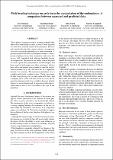Files in this item
Pitch bending technique on early horns by manipulation of the embouchure : a comparison between measured and predicted data
Item metadata
| dc.contributor.author | Norman, Lisa | |
| dc.contributor.author | Kemp, Jonathan A | |
| dc.contributor.author | Chick, John | |
| dc.contributor.author | Campbell, Murray | |
| dc.contributor.editor | Bresin, Roberto | |
| dc.contributor.editor | Askenfelt, Anders | |
| dc.date.accessioned | 2013-08-09T09:31:02Z | |
| dc.date.available | 2013-08-09T09:31:02Z | |
| dc.date.issued | 2013-07-30 | |
| dc.identifier | 63626064 | |
| dc.identifier | 988bf7ce-9f46-4278-8968-e20fdcebd74d | |
| dc.identifier.citation | Norman , L , Kemp , J A , Chick , J & Campbell , M 2013 , Pitch bending technique on early horns by manipulation of the embouchure : a comparison between measured and predicted data . in R Bresin & A Askenfelt (eds) , Proceedings of the Stockholm Music Acoustics Conference 2013 : 4th Stockholm Music Acoustics Conference . Royal Institute of Technology (KTH) , Stockholm , pp. 534-539 , Proceedings of the Stockholm Music Acoustics Conference 2013, SMAC 2013 , Stockholm , Sweden , 30/07/13 . | en |
| dc.identifier.citation | conference | en |
| dc.identifier.isbn | 978-91-7501-830-0 | |
| dc.identifier.other | ORCID: /0000-0002-3861-4863/work/37034227 | |
| dc.identifier.uri | https://hdl.handle.net/10023/3951 | |
| dc.description.abstract | Brass players sometimes adopt a technique whereby they adjust their embouchure in order to alter or bend the pitch of a note away from the centre of the resonance. The ease and control with which this can be achieved is an important factor in assessing the playability of a brass instrument. A good instrument will have well defined resonances, but experienced players do not like instruments with notes that are too ‘stiff’, and which lack sufficient flexibility for musical expression. The need for the ability to bend the pitch of a note is particularly important for natural trumpets and horns used in the baroque era, when instruments did not have valves and players were required to bend the pitch of some resonances (e.g. the 11th and 13th) by a significant fraction of a semitone. The instrument and player form a complex and closely coupled system. Using experimental data from playing tests on early orchestral horns, and comparing these results with those from a recently developed time domain model, it is possible to begin to identify features of an instrument and its interaction with a player which make it more or less susceptible to this type of manipulation. | |
| dc.format.extent | 6 | |
| dc.format.extent | 2804391 | |
| dc.language.iso | eng | |
| dc.publisher | Royal Institute of Technology (KTH) | |
| dc.relation.ispartof | Proceedings of the Stockholm Music Acoustics Conference 2013 | en |
| dc.subject | Lip | en |
| dc.subject | Horn | en |
| dc.subject | Physical modelling | en |
| dc.subject | Synthesis | en |
| dc.subject | Bend | en |
| dc.subject | ML Literature of music | en |
| dc.subject | QC Physics | en |
| dc.subject | Acoustics and Ultrasonics | en |
| dc.subject.lcc | ML | en |
| dc.subject.lcc | QC | en |
| dc.title | Pitch bending technique on early horns by manipulation of the embouchure : a comparison between measured and predicted data | en |
| dc.type | Conference item | en |
| dc.contributor.institution | University of St Andrews. Music Centre | en |
| dc.identifier.url | http://www.speech.kth.se/smac-smc-2013/proceedings/SMAC2013_Proceedings_online-version.pdf | en |
This item appears in the following Collection(s)
Items in the St Andrews Research Repository are protected by copyright, with all rights reserved, unless otherwise indicated.

